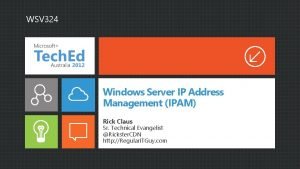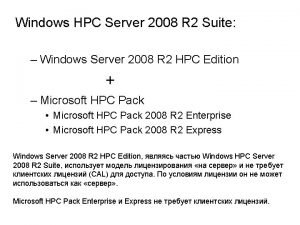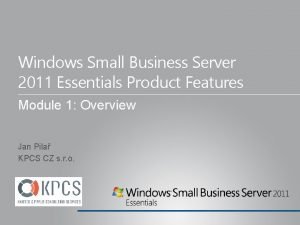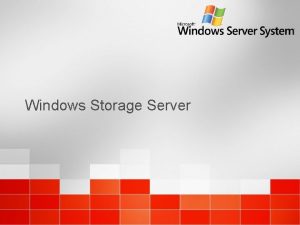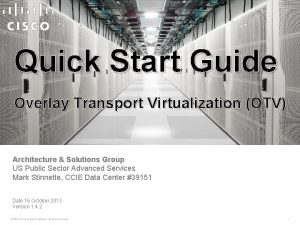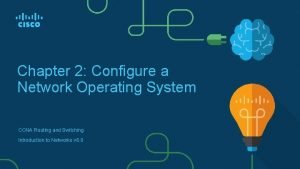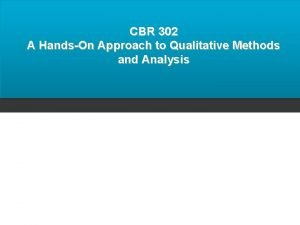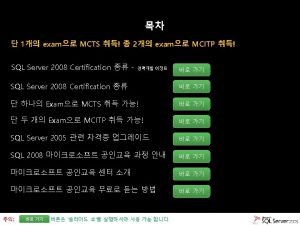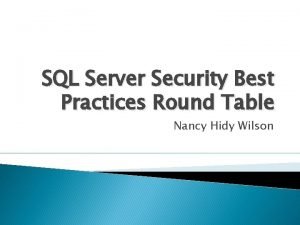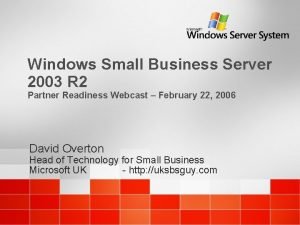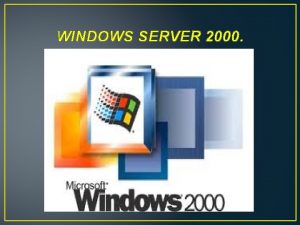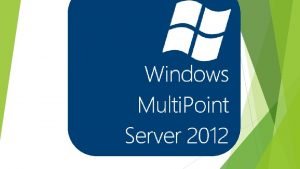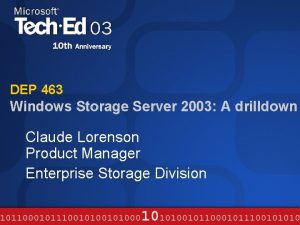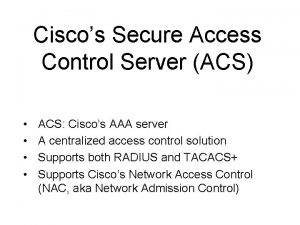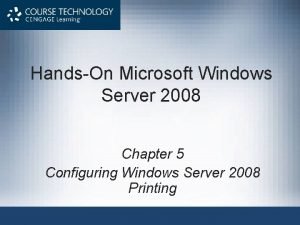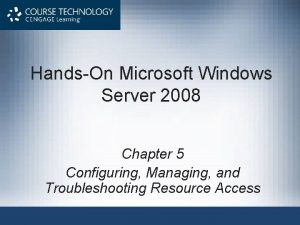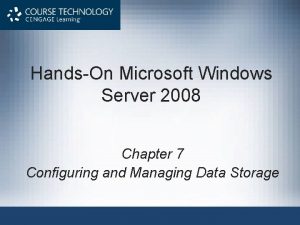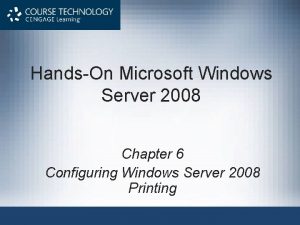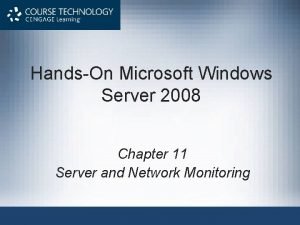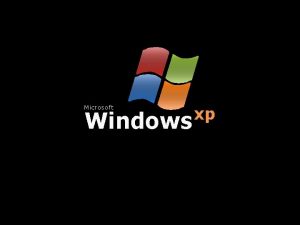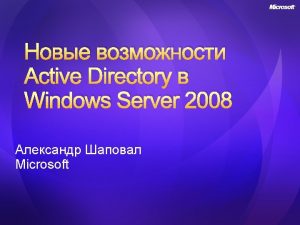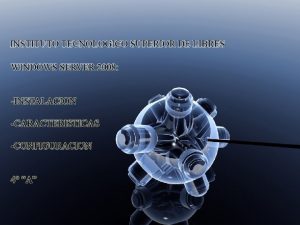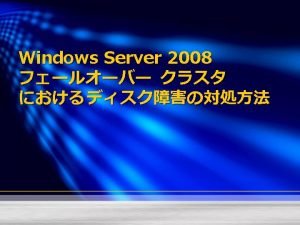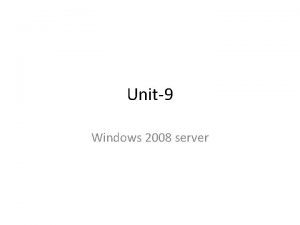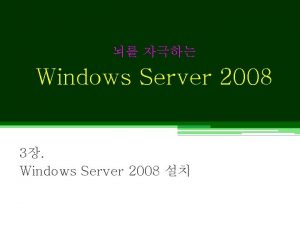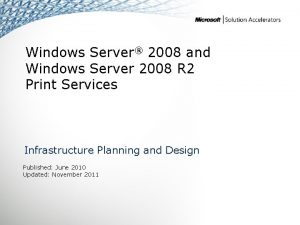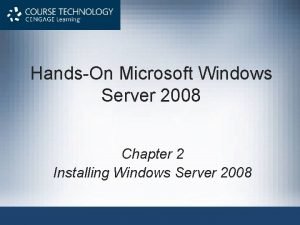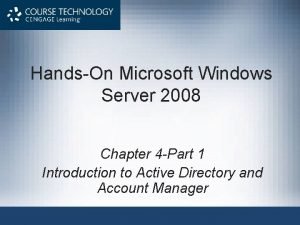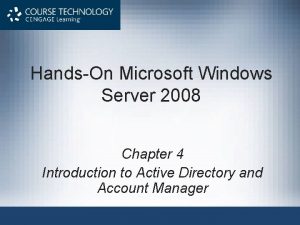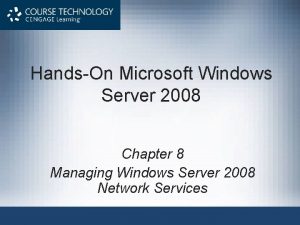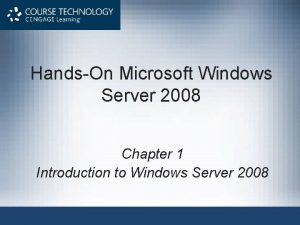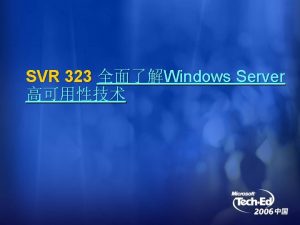HandsOn Microsoft Windows Server 2008 Chapter 3 Configuring
































- Slides: 32

Hands-On Microsoft Windows Server 2008 Chapter 3 Configuring the Windows Server 2008 Environment

Objectives • Use Server Manager and Server. Manager. Cmd. exe to manage a server • Install and remove server roles • Configure server hardware • Configure the operating system • Use the Security Configuration Wizard to harden a server Hands-On Microsoft Windows Server 2008 2

Using Server Manager • Server Manager – Groups administrative functions to make a server easier to manage • Roles Summary feature – Displays log information to alert you to warnings or problems Hands-On Microsoft Windows Server 2008 3

Hands-On Microsoft Windows Server 2008 4

Using Server Manager (continued) • Activity 3 -1: Getting to Know Server Manager – Time Required: Approximately 15 minutes – Objective: Learn how to start and use Server Manager Hands-On Microsoft Windows Server 2008 5

Installing and Removing Server Roles • Two common roles for a Windows Server 2008 server – File Services role • Focuses on sharing files from the server or using the server to coordinate and simplify file sharing through Distributed File System (DFS) – Print Services role • Used to manage network printing services and it can offer one or more network printers connected to the network through the server itself Hands-On Microsoft Windows Server 2008 6

Installing and Removing Server Roles (continued) • Activity 3 -2: Installing and Removing Two Server Roles – Time Required: Approximately 20 minutes – Objective: Install and then remove the File Services and Print Services roles in Windows Server 2008 Hands-On Microsoft Windows Server 2008 7

Using Server. Manager. Cmd. exe • Server. Manager. Cmd. exe – It is the Command-line version of server manager – Used for: • Managing server roles • Manage features that are to be added or removed • Management activities – Install a role or feature – Remove a role or feature – Query to determine what roles and features are installed Hands-On Microsoft Windows Server 2008 8

Using Server. Manager. Cmd. exe (continued) • Management activities (continued) – Determine which features and services will be installed by a specific role, before actually installing that role – Restart the computer after installing or removing a role or feature – Specify particular features or services to install with a role Hands-On Microsoft Windows Server 2008 9

Configuring Server Hardware Devices • Hardware devices can include the following: – – – – Disk drives Disk controllers Network adapters CD/DVD drives Keyboard Pointing devices Monitor Hands-On Microsoft Windows Server 2008 10

Plug and Play • Plug and Play (Pn. P) – The ability to automatically detect and configure newly installed hardware devices • For this capability to work, Pn. P must be: – Built into the device – Enabled in the target computer’s BIOS – Built into the computer operating system kernel • Pn. P eliminates hours of time that server administrators and computer users once spent installing and configuring hardware Hands-On Microsoft Windows Server 2008 11

Using Control Panel and the Add Hardware Wizard • The Add Hardware Wizard is used for the following tasks: – Invoke the operating system to use Pn. P to detect new hardware – Install new non-Pn. P hardware and hardware drivers – Troubleshoot problems you might be having with existing hardware • The Add Hardware Wizard is started from Control Panel • Windows Server 2008 provides two Control Panel view options: Control Panel Home and Classic View Hands-On Microsoft Windows Server 2008 12

Hands-On Microsoft Windows Server 2008 13

Using Control Panel and the Add Hardware Wizard (continued) • Device Manager – Used to check for a resource conflict and to examine other properties associated with a device – Provides a graphical view of all hardware currently installed on your computer – Can also be used to: • • • Verify if hardware installed is working properly Update device drivers Disable a device Uninstall a device Configure the settings for a device Hands-On Microsoft Windows Server 2008 14

Using Control Panel and the Add Hardware Wizard (continued) • Activity 3 -4: Resolving a Resource Conflict – Time Required: Approximately 10 minutes – Objective: Use Device Manager to resolve a resource conflict Hands-On Microsoft Windows Server 2008 15

Using Control Panel and the Add Hardware Wizard (continued) • Driver signing – When a driver is verified, a unique digital signature is incorporated into it – When Windows Server 2008 determines that a device driver is not signed, it gives you a warning – Device drivers that are unsigned cannot be loaded in x 64 versions of Windows Server 2008 Hands-On Microsoft Windows Server 2008 16

Using Control Panel and the Add Hardware Wizard (continued) • Use the System File Checker – Scan all system files to verify integrity – Scan and replace files as needed – Scan only certain files • The System File Checker can be manually run from the Command Prompt window Hands-On Microsoft Windows Server 2008 17

Using Control Panel and the Add Hardware Wizard (continued) • Activity 3 -5: Manually Running the System File Checker – Time Required: Approximately 5 minutes to learn about the command options and 10– 30 minutes to run the test – Objective: Use the System File Checker to verify system files Hands-On Microsoft Windows Server 2008 18

Configuring the Operating System • After the operating system has been installed – It can be configured to optimize performance and meet very specific requirements Hands-On Microsoft Windows Server 2008 19

Configuring Performance Options • Configuring processor scheduling and Data Execution Prevention – Processor scheduling • Allows you to configure how processor resources are allocated to programs – Data Execution Prevention (DEP) • Monitors how programs use memory to ensure they are not causing memory problems Hands-On Microsoft Windows Server 2008 20

Configuring Performance Options (continued) • Activity 3 -7: Configuring Processor Scheduling and DEP – Time Required: Approximately 10 minutes – Objective: Learn where to set up processor scheduling and system memory protection Hands-On Microsoft Windows Server 2008 21

Configuring Performance Options (continued) • Configuring virtual memory – Virtual memory • Disk storage used to expand the capacity of the physical RAM installed in the computer – The area of disk that is allocated for this purpose is called the paging file – Example: Your Hard disk This portion in the hard disk creates Virtual Memory Hands-On Microsoft Windows Server 2008 ing Pag File 22

Configuring Performance Options (continued) • Tips for placement of the paging file: – Server performance is better if the paging file is not placed on the boot partition • Boot partition The partition that contains the default operating system (the default operating system is the one that directly appears to you after you turn on your computer) – If there are multiple disks, performance can be improved by placing a paging file on each disk Hands-On Microsoft Windows Server 2008 23

Configuring Startup and Recovery • You can configure the following system startup options: – Which operating system to boot by default, if more than one operating system is installed – How long to display a list of operating systems from which to boot – How long to display a list of recovery options, if the computer needs to go into recovery mode after a system failure Hands-On Microsoft Windows Server 2008 24

Configuring Startup and Recovery (continued) • In the event of a system failure, you can configure these options: – Writing information to the system log – Whether to start automatically after a system failure – How and where to write debugging information Hands-On Microsoft Windows Server 2008 25

Configuring Startup and Recovery (continued) • Activity 3 -11: Configuring Startup and Recovery – Time Required: Approximately 5 minutes – Objective: Configure startup and recovery options Hands-On Microsoft Windows Server 2008 26

Configuring Power Options • The Power Options that you can set are as follows: – – – Select a power plan Require a password on wakeup Choose what the power button does Create a power plan Choose when to turn off the display • Three power plans are already created: balanced, power saver, and high performance • The option to create a power plan enables you to customize a power plan Hands-On Microsoft Windows Server 2008 27

Configuring Power Options (continued) • Activity 3 -12: Configuring Power Options – Time Required: Approximately 5 minutes – Objective: Configure the balanced power plan Hands-On Microsoft Windows Server 2008 28

Using the Security Configuration Wizard • Security Configuration Wizard (SCW) – Used for analyzing and configuring security settings on a server • SCW examines the roles a server plays – And then tries to adjust security to match these roles Hands-On Microsoft Windows Server 2008 29

Using the Security Configuration Wizard (continued) • Through the SCW, you can: – Disable unnecessary services and software – Close network communication ports and other communication resources that aren’t in use – Examine shared files and folders to help manage network access through access protocols – Configure firewall rules Hands-On Microsoft Windows Server 2008 30

Hands-On Microsoft Windows Server 2008 31

Using the Security Configuration Wizard (continued) • Activity 3 -15: Using SCW to Configure a Security Policy – Time Required: Approximately 20– 30 minutes – Objective: Create a new security policy Hands-On Microsoft Windows Server 2008 32
 Windows server 2008 ip address management
Windows server 2008 ip address management Windows server 2008
Windows server 2008 Sql server management studio express 2005
Sql server management studio express 2005 Small business server 2010
Small business server 2010 Microsoft windows small business server 2011 essentials
Microsoft windows small business server 2011 essentials Windows storage server 2003
Windows storage server 2003 Microsoft windows movie maker windows 7
Microsoft windows movie maker windows 7 Parse human becoming theory pdf
Parse human becoming theory pdf Otv configuration
Otv configuration Dansguardian download
Dansguardian download Configure a network operating system
Configure a network operating system Configure a network operating system
Configure a network operating system Packet tracer configuring multiarea ospfv2
Packet tracer configuring multiarea ospfv2 2008 2008
2008 2008 This is the religion that god accepts
This is the religion that god accepts Alsa route plugin
Alsa route plugin Analytical research
Analytical research James handson
James handson James handson
James handson A handson
A handson Handson activities
Handson activities Handson activities
Handson activities Handson session
Handson session Sql server 2008 certification
Sql server 2008 certification Microsoft sql server security best practices
Microsoft sql server security best practices Microsoft robotics studio
Microsoft robotics studio Windows small business server 2003
Windows small business server 2003 Windows server 2000 caracteristicas
Windows server 2000 caracteristicas Multipoint dashboard
Multipoint dashboard Windows server migration tools
Windows server migration tools Windows storage server 2003
Windows storage server 2003 Secure access acs
Secure access acs Windows server codename longhorn
Windows server codename longhorn
